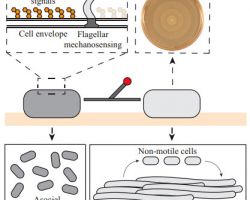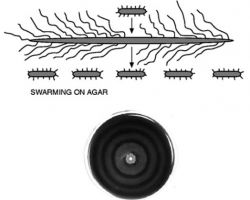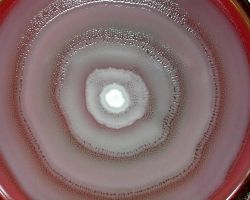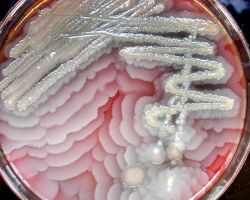SEARCH
Search
Motility_Proteus mirabilis
-
General
♦ Swarming
Is a rapid (2–10 μm/s) and coordinated translocation of a bacterial population across solid or semi-solid surfaces, and is an example of bacterial multicellularit and swarm behaviour.
♦ Proteus mirabilis morphology and swimming on agar
Short swimmer cells, when plated on an agar surface differentiate into elongated, multinuclear heavily flagellated swarmer cells (up to 80 μm long).
Swarmer cells associate with one another and spread away from the point of inoculation. After several hours, swarmer cells consolidate into numerous swimmer cells thus completing the cycle.
Alternating cycles of differentiation and consolidation result in a bull's-eye pattern of swarming on an agar plate.
♦ Flagellar arangement
Peritrichous
Flagella are left-handed helices, and bundle and rotate together only when rotating counterclockwise. When some of the rotors reverse direction, the flagella unwind and the cell starts "tumbling".
Even if all flagella would rotate clockwise, they likely will not form a bundle.
Such "tumbling" may happen occasionally, leading to the cell seemingly thrashing about in place, resulting in the reorientation of the cell. The clockwise rotation of a flagellum is suppressed by chemical compounds favorable to the cell (e.g. food), but the motor is highly adaptive to this. Therefore, when moving in a favorable direction, the concentration of the chemical attractant increases and "tumbles" are continually suppressed; however, when the cell's direction of motion is unfavorable (e.g., away from a chemical attractant), tumbles are no longer suppressed and occur much more often, with the chance that the cell will be thus reoriented in the correct direction.
See: MOTILITY
-
History
-
Related
-
References
wikipedia
Photo
MMIZ, ErasmusMC, Rotterdam
wikipedia
https://www.biorxiv.org/content/biorxiv/early/2018/08/23/398321.full.pdf
https://www.sciencedirect.com/topics/immunology-and-microbiology/proteus-mirabilis




